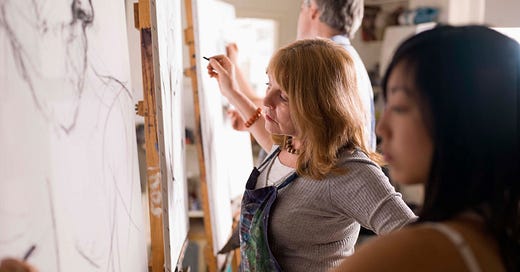Last week I received the community ed class schedule for our local community college. For the first time in a long time, I flipped through the newspaper print pages skimming it cover to cover, circling classes I wanted to take.
I found myself marking up almost entire pages, particularly the art section: “Nature Journaling,” “Drawing at the Portland Art Museum,” “Botanical Illustration”! It all sounded so fun. There were even writing classes that are so up my alley: “Reading and Writing Stories in the End Times” and “Weird Fiction Workshop.”
Beyond the arts, there were earthquake preparedness courses, grant writing courses, and cooking courses. Why had I not dug into community college offerings more? I wondered to myself.
The answer, of course, is time. I’ve taken occasional remote classes form PCC such as identifying plants and foraging for beginners (which honestly is only so helpful when it’s online and not out in the woods). They were fun and interesting, but I hadn’t really dug in deeper, especially for in-person classes because being a working mom with a spouse who has an inflexible schedule can be a challenge. By the time I convinced myself to sign up for the “Drawing at the Portland Art Museum” class, though, it was a few days after registration opened and both sections were sold out. In fact, all the classes I was interested in were.
I was disappointed, of course, but I knew the array of offerings from the community college is a constant. And that is exactly what makes the community college so wonderful. It is a public, local resource that we should all be investing in. It’s a great thing these classes are full because it means they’re being utilized.
With a dad who spent his entire career as a community college professor—teaching English and communication studies—I was raised in a home that valued community colleges. While I ended up going to a four-year college, my dad and I had a lot of conversations about how essential community colleges are. They make secondary education accessible, but they also create a link to the community. They are public resource that helps maintain the vibrancy of a community.
Thinking about why community colleges are so important reminded me of a conversation I had with
last year for a story about our babysitting co-op for Romper. We talked about her incredible book, Essential Labor, where she not only goes deeply into the transformative and social change-making role that mothers have in society, she is also proposing that we need a culture change around relying on one another and becoming a more collective society. In our chat for my Romper story, I asked her what steps we can take to change that culture of individualism. What she proposes was fairly simple: utilize the public spaces and community-oriented resources around us. Community centers, public libraries, parks and recreation, public schools, and I’ll even add community colleges there.While community college classes aren’t free, they cost far less than what one would pay for these classes from private entities. When we utilize these publicly available resource, we’re doing our part to invest emotionally in our community. And from a preparedness perspective, it’s so incredible to see all of the instructors who are teaching these skills. So many people with valuable skills to pass on to others. It’s a part of sharing and connecting more deeply with one another.
“We don’t need to re-create social structures wholesale, but we could learn more communal aspects of living, use them to rethink and reshape American family life,” Garbes writes in Essential Labor.
And in light of what is becoming a bit of an unintentional series about resisting “toxic individualism” (which one of my readers called it in a past comment), it shows that resisting the entities trying to tear us apart (e.g., a fascist government) can be joyful. It can look like protesting on the street, but it also can be learning to draw with several strangers in an art museum.






I miss Jill Biden!